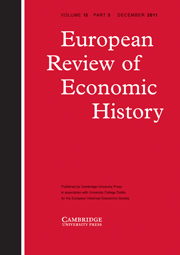Crossref Citations
This article has been cited by the following publications. This list is generated based on data provided by
Crossref.
SMITH, S. D.
2011.
DETERMINING THE INDUSTRIAL REVOLUTION.
The Historical Journal,
Vol. 54,
Issue. 3,
p.
907.
Clark, Gregory
2012.
A Review Essay on The Enlightened Economy: An Economic History of Britain 1700–1850 by Joel Mokyr.
Journal of Economic Literature,
Vol. 50,
Issue. 1,
p.
85.
Pearson, Peter J.G.
and
Foxon, Timothy J.
2012.
A low carbon industrial revolution? Insights and challenges from past technological and economic transformations.
Energy Policy,
Vol. 50,
Issue. ,
p.
117.
2013.
Cotton.
p.
296.
Faith, Rosamond
Davis, James
Paul, Helen
Murphy, Anne L.
Crook, Tom
Velkar, Aashish
and
Godden, Chris
2013.
Review of periodical literature published in 2011.
The Economic History Review,
Vol. 66,
Issue. 1,
p.
297.
Gragnolati, Ugo M.
Moschella, Daniele
and
Pugliese, Emanuele
2014.
The spinning jenny and the guillotine: technology diffusion at the time of revolutions.
Cliometrica,
Vol. 8,
Issue. 1,
p.
5.
Crafts, Nicholas
and
O’Rourke, Kevin Hjortshøj
2014.
Vol. 2,
Issue. ,
p.
263.
Marttnez-Galarraga, Julio
and
Prat, Marc
2014.
Wages and Prices in Early Catalan Industrialisation.
SSRN Electronic Journal,
Magnusson, Lars
2014.
Business history and the history of work – a contested relationship.
Business History,
Vol. 56,
Issue. 1,
p.
71.
Faundez, Julio
2014.
Douglass North's Theory of Institutions: Lessons for Law and Development.
SSRN Electronic Journal,
Pfister, Ulrich
2015.
The quantitative development of Germany’s international trade during the eighteenth and early nineteenth centuries.
Revue de l'OFCE,
Vol. N° 140,
Issue. 4,
p.
175.
Faundez, Julio
2016.
Douglass North’s Theory of Institutions: Lessons for Law and Development.
Hague Journal on the Rule of Law,
Vol. 8,
Issue. 2,
p.
373.
Martínez‐Galarraga, Julio
and
Prat, Marc
2016.
Wages, prices, and technology in early Catalan industrialization.
The Economic History Review,
Vol. 69,
Issue. 2,
p.
548.
Pearson, Peter J. G.
2016.
The New Palgrave Dictionary of Economics.
p.
1.
Dudley, Leonard
2016.
Language standardization and the Industrial Revolution.
Oxford Economic Papers,
p.
gpw059.
Broadberry, Stephen
Ghosal, Sayantan
and
Proto, Eugenio
2017.
Anonymity, efficiency wages and technological progress.
Journal of Development Economics,
Vol. 127,
Issue. ,
p.
379.
Khan, B. Zorina
2018.
Human capital, knowledge and economic development: evidence from the British Industrial Revolution, 1750–1930.
Cliometrica,
Vol. 12,
Issue. 2,
p.
313.
Bakker, Gerben
2018.
An Economist’s Guide to Economic History.
p.
211.
Pearson, Peter J. G.
2018.
The New Palgrave Dictionary of Economics.
p.
3674.
Heblich, Stephan
and
Trew, Alex
2019.
Banking and Industrialization.
Journal of the European Economic Association,
Vol. 17,
Issue. 6,
p.
1753.


